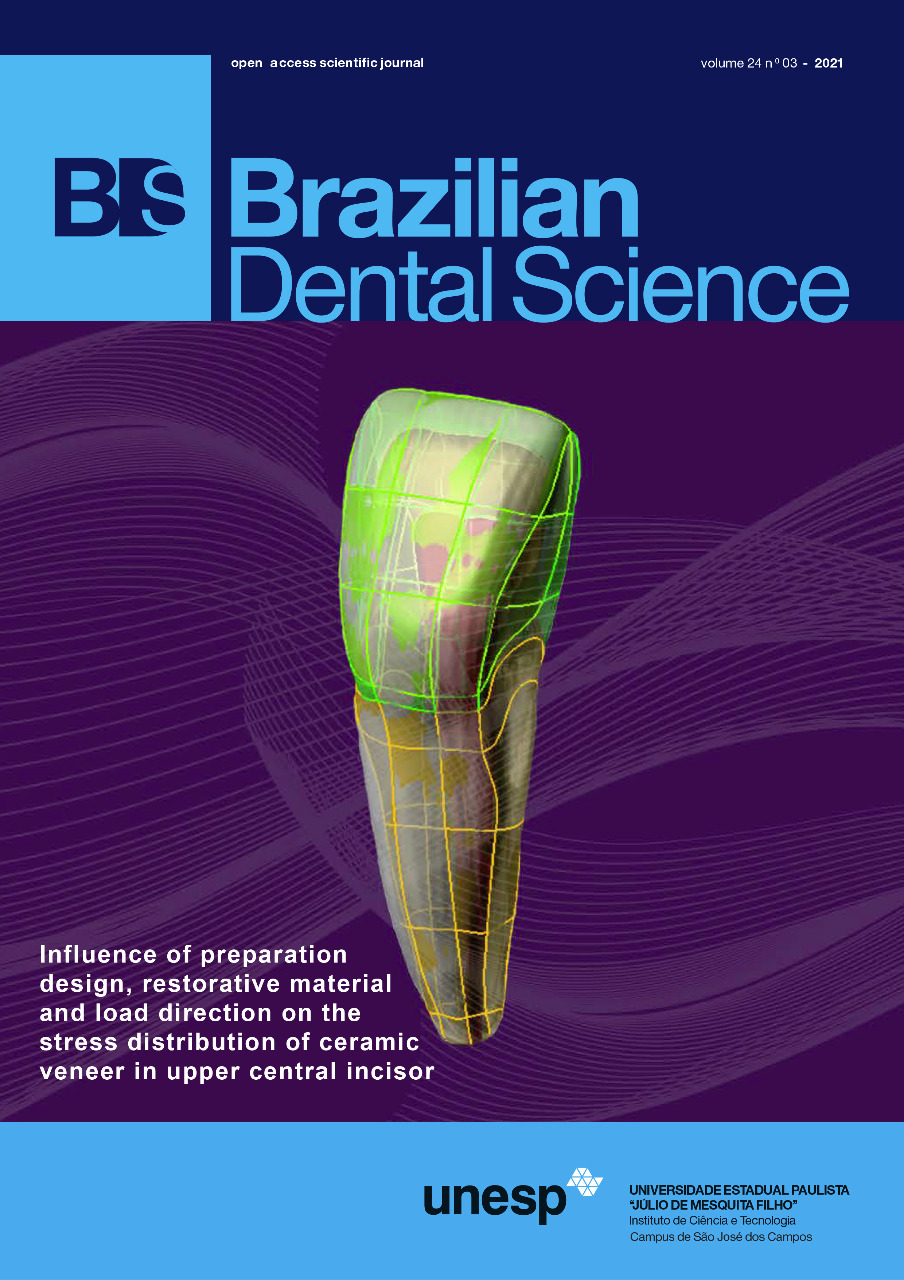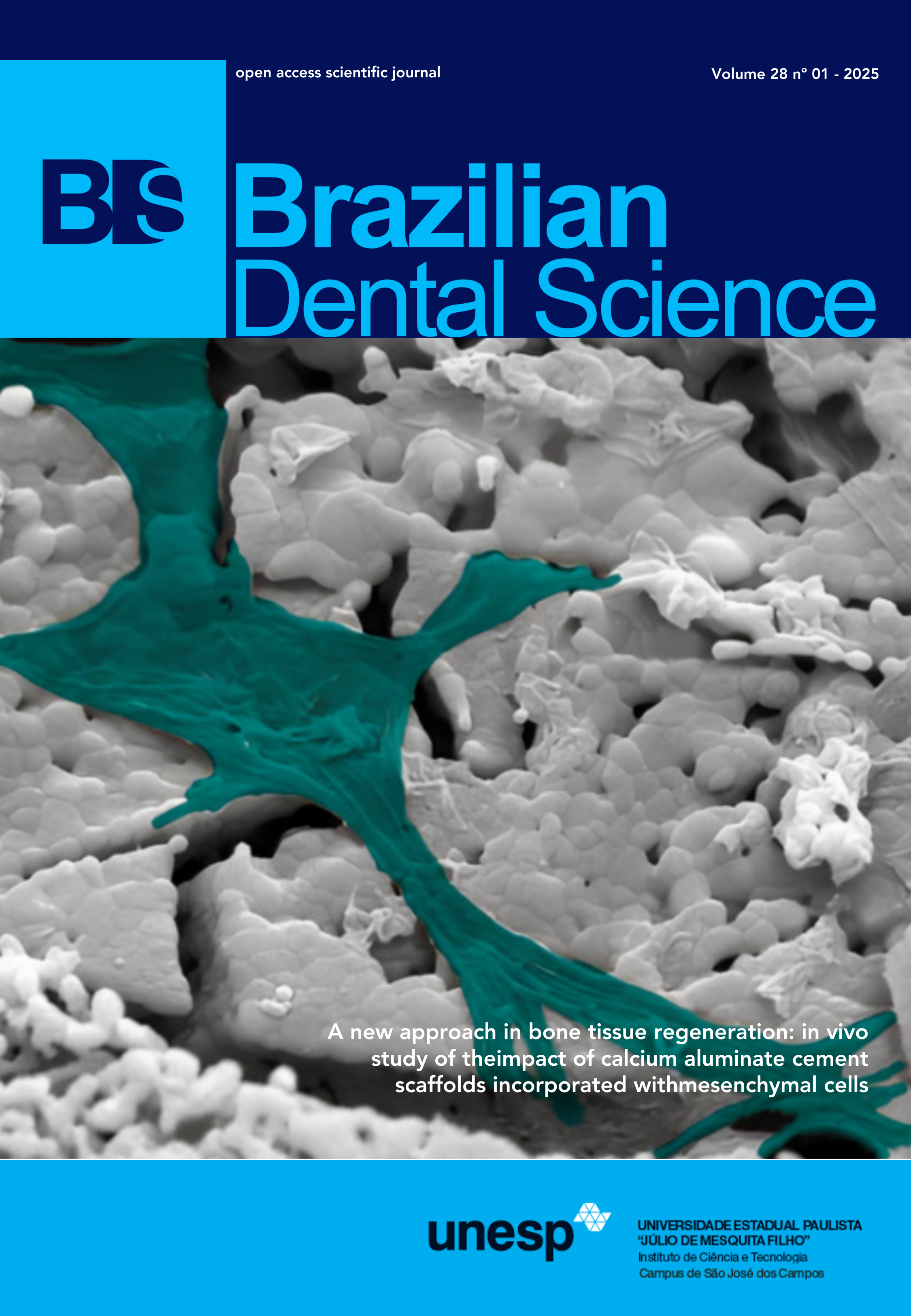Biochemical and histopathological effects of diclofenac and ketoprofen administration on bone regeneration
DOI:
https://doi.org/10.14295/bds.2021.v24i3.2491Resumen
Objective: To evaluate the biochemical and histopathological effects of diclofenac and ketoprofen administration on bone regeneration in a calvarial defect model in rats. Material and Methods: The sample consisted of 108 Wistar rats that were randomly distributed in three groups, to which an osteotomy of 6 mm in diameter was performed in the calvaria. Group A (control) was given saline solution; Group B received ketoprofen 2 mg/kg and Group C received diclofenac 2 mg/kg. All treatments were administered intraperitoneally every 12 hours for 3 days. Bone regeneration was evaluated by biochemical (alkaline phosphatase and serum calcium) and histopathological (osteocyte and osteoblast cell count) characteristics at 15 and 30 days. Results: In the biochemical evaluation, alkaline phosphatase levels in the ketoprofen group were significantly lower compared to the diclofenac group at 15 and 30 days (p= 0.015 and p= 0.001; respectively). However, serum calcium levels did not show the difference between the study groups at 15 and 30 days (p= 0.42 and p= 0.81; respectively). In the histopathological analysis, the count of osteoblasts and osteocytes was significantly lower in the ketoprofen group compared to the diclofenac group at 15 and 30 days (p< 0.05). Conclusion: The administration of ketoprofen has negative biochemical and histopathological effects of greater intensity on bone regeneration compared to the administration of diclofenac.
Keywords
Bone regeneration; Non-steroidal anti-inflammatory agents; Diclofenac; Ketoprofen; Rats.
Descargas
Citas
References
Etikala A, Tattan M, Askar H, Wang HL. Effects of NSAIDs on periodontal and dental Implant therapy. Compend Contin Educ Dent. 2019;40(2):e1-e9.
Zimmerman SM, Heard-Lipsmeyer ME, Dimori M, Thostenson JD, Mannen EM, O’Brien CA, et al. Loss of RANKL in osteocytes dramatically increases cancellous bone mass in the osteogenesis imperfecta mouse (oim). Bone Rep. 2018;9:61–73. doi: 10.1016/j.bonr.2018.06.008
Giannoudis PV, Hak D, Sanders D, Donohoe E, Tosounidis T, Bahney C. Inflammation, bone healing, and anti-inflammatory drugs: an update. J Orthop Trauma. 2015;29 Suppl 12:S6-9. doi: 10.1097/BOT.0000000000000465.
Sauerschnig M, Stolberg-Stolberg J, Schmidt C, Wienerroither V, Plecko M, Schlichting K, et al. Effect of COX-2 inhibition on tendon-to-bone healing and PGE2 concentration after anterior cruciate ligament reconstruction. Eur J Med Res. 2018;23(1):1. doi: 10.1186/s40001-017-0297-2
Oliveira MR, de CSA, Ferreira S, Avelino CC, Garcia IR Jr, Mariano RC. Influence of the association between platelet-rich fibrin and bovine bone on bone regeneration: a histomorphometric study in the calvaria of rats. Int J Oral Maxilofac Surg. 2015;44(5):649–55.
Gomes FIF, Aragão MGB, Pinto VPT, Gondim DV, Barroso FC, Silva AAR, et al. Effects of nonsteroidal anti-inflammatory drugs on osseointegration: a review. J Oral Implantol. 2015;41(2):219-30.
Bissinger O, Kreutzer K, Gotz C, Hapfelmeier A, Pautke C, Vogt S, et al. A biomechanical, micro-computertomographic and histological analysis of the influence of diclofenac and prednisolone on fracture healing in vivo. BMC Musculoskelet Disord. 2016;17(1):383.
Cai WX, Ma L, Zheng LW, Kruse-Gujer A, Stubinger S, Lang NP, et al. Influence of non-steroidal anti-inflammatory drugs (NSAIDs) on osseointegration of dental implants in rabbit calvaria. Clin Oral Implants Res. 2015;26(4):478-83.
Liu Y, Fang S, Li X, Feng J, Du J, Guo L, et al. Aspirin inhibits LPS-induced macrophage activation via the NF-kappaB pathway. Sci Rep. 2017;7(1):11549.
Luo JD, Miller C, Jirjis T, Nasir M, Sharma D. The effect of non-steroidal anti-inflammatory drugs on the osteogenic activity in osseointegration: a systematic review. Int J Implant Dent. 2018;4(1):30.
Garcia-Martinez O, Luna-Bertos E, Ramos-Torrecillas J, Manzano-Moreno FJ, Ruiz C. Repercussions of NSAIDS drugs on bone tissue: the osteoblast. Life Sci. 2015;123:72–7.
Winnett B, Tenenbaum HC, Ganss B, Jokstad A. Perioperative use of non-steroidal anti-inflammatory drugs might impair dental implant osseointegration. Clin Oral Implants Res. 2016;27(2):e1-7.
Xie Y, Pan M, Gao Y, Zhang L, Ge W, Tang P. Dose-dependent roles of aspirin and other non-steroidal anti-inflammatory drugs in abnormal bone remodeling and skeletal regeneration. Cell Biosci. 2019;9:103.
Salduz A, Dikici F, Kilicoglu OI, Balci HI, Akgul T, Kurkcu M, et al. Effects of NSAIDs and hydroxyapatite coating on osseointegration. J Orthop Surg . 2017;25(1):23-9. doi: 10.1177/2309499016684410.
National Research Council (US) Committee for the Update of the Guide for the Care and Use of Laboratory Animals [Internet]. 8th ed. Washington (DC): National Academies Press (US); 2011 [cited 2020 May 8]. (The National Academies Collection: Reports funded by National Institutes of Health). Available from: http://www.ncbi.nlm.nih.gov/books/NBK54050/
Messora MR, Nagata MJ, Dornelles RC, Bomfim SR, Furlaneto FA, Melo LG, et al. Bone healing in critical-size defects treated with platelet-rich plasma: a histologic and histometric study in rat calvaria. J Periodontal Res. 2008;43(2):217-23.
Melguizo-Rodríguez L, Costela-Ruiz VJ, Manzano-Moreno FJ, Illescas-Montes R, Ramos-Torrecillas J, García-Martínez O, et al. Repercussion of nonsteroidal anti-inflammatory drugs on the gene expression of human osteoblasts. PeerJ. 2018;6:e5415–e5415.
Manzano-Moreno FJ, Costela-Ruiz VJ, Melguizo-Rodriguez L, Illescas-Montes R, Garcia-Martinez O, Ruiz C, et al. Inhibition of VEGF gene expression in osteoblast cells by different NSAIDs. Arch Oral Biol. 2018;92:75-8.
Inal S, Kabay S, Cayci MK, Kuru HI, Altikat S, Akkas G, et al. Comparison of the effects of dexketoprofen trometamol, meloxicam and diclofenac sodium on fibular fracture healing, kidney and liver: an experimental rat model. Injury. 2014;45(3):494-500.
Huo MH, Troiano NW, Pelker RR, Gundberg CM, Friedlaender GE. The influence of ibuprofen on fracture repair: biomechanical, biochemical, histologic, and histomorphometric parameters in rats. J Orthop Res. 1991;9(3):383-90.
Krischak GD, Augat P, Blakytny R, Claes L, Kinzl L, Beck A. The non-steroidal anti-inflammatory drug diclofenac reduces appearance of osteoblasts in bone defect healing in rats. Arch Orthop Trauma Surg. 2007;127(6):453–8.
Simon AM, O’Connor JP. Dose and time-dependent effects of cyclooxygenase-2 inhibition on fracture-healing. J Bone Joint Surg Am. 2007;89(3):500–11.
Zhang X, Schwarz EM, Young DA, Puzas JE, Rosier RN, O’Keefe RJ. Cyclooxygenase-2 regulates mesenchymal cell differentiation into the osteoblast lineage and is critically involved in bone repair. J Clin Invest. 2002;109(11):1405-15.
Borgeat A, Ofner C, Saporito A, Farshad M, Aguirre J. The effect of nonsteroidal anti-inflammatory drugs on bone healing in humans: A qualitative, systematic review. J Clin Anesth. 2018;49:92-100.
Duchman KR, Lemmex DB, Patel SH, Ledbetter L, Garrigues GE, Riboh JC. The effect of non-steroidal anti-inflammatory drugs on tendon-to-bone healing: a systematic review with subgroup meta-analysis. Iowa Orthop J. 2019;39(1):107–19.
Descargas
Publicado
Cómo citar
Número
Sección
Licencia
Brazilian Dental Science uses the Creative Commons (CC-BY 4.0) license, thus preserving the integrity of articles in an open access environment. The journal allows the author to retain publishing rights without restrictions.
=================
COPYRIGHT TRANSFER AND RESPONSIBILITY STATEMENT
(PDF)
For all articles published in the BDS journal, copyright is retained by the authors. Articles are licensed under an open-access Creative Commons CC BY 4.0 license, meaning that anyone may download and read the paper for free. In addition, the article may be reused and quoted, provided that the original published version is cited. These conditions allow for maximum use and exposure of the work while ensuring that the authors receive proper credit. All metadata associated with published articles is released under the Creative Commons CC0 Universal Public Domain Dedication.
Before the submission, authors must obtain permission to reproduce any published material (figures, schemes, tables, or any extract of a text) that does not fall into the public domain or for which they do not hold the copyright. Permission should be requested by the authors from the copyright holder (usually the Publisher, please refer to the imprint of the individual publications to identify the copyright holder).
The authors hereby attest that the study is original and does not present manipulated data, fraud, or plagiarism. All names listed made a significant scientific contribution to the study, are aware of the presented data, and agree with the final version of the manuscript. They assume complete responsibility for the ethical aspects of the study.
This text must be printed and signed by all authors. The scanned version should be submitted as supplemental file during the submission process.




